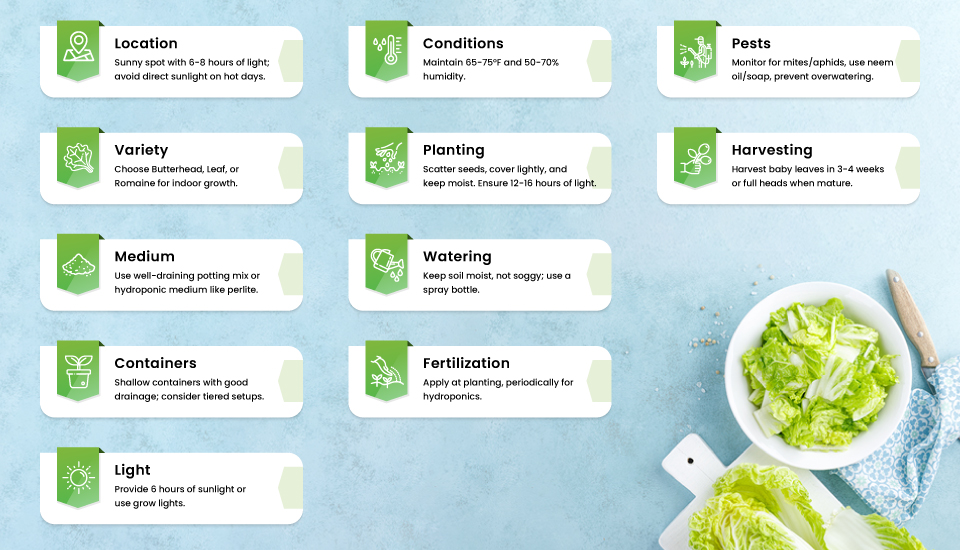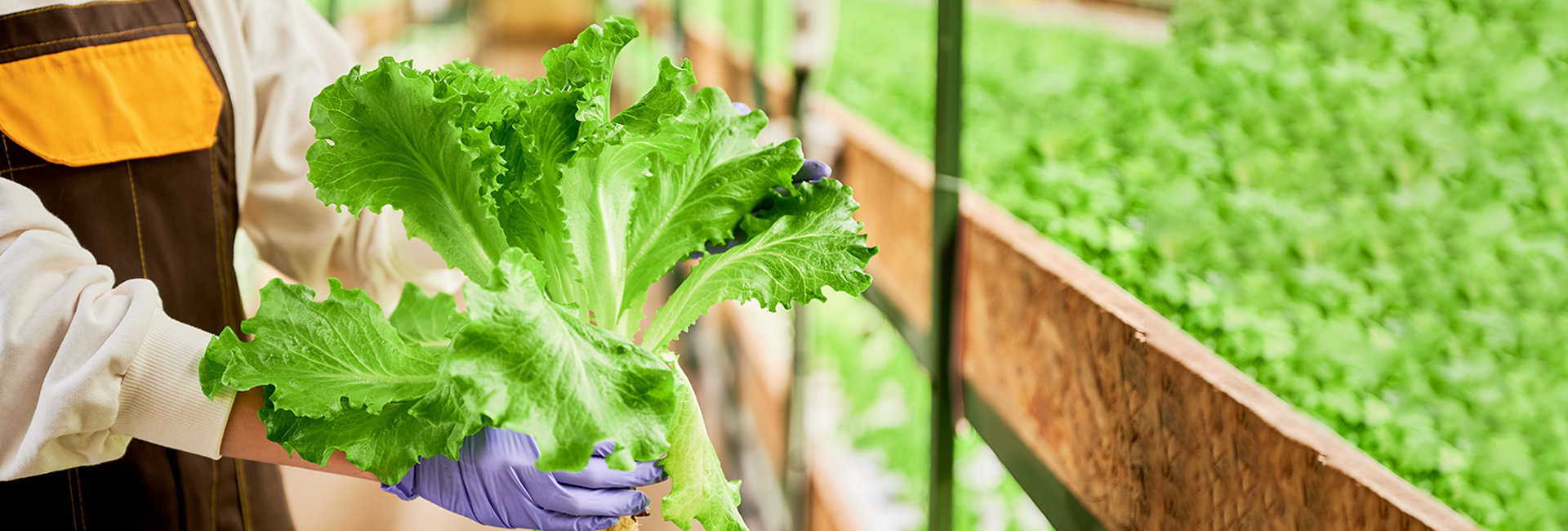Want to grow lettuce out-of-season? Do your lettuce plants have issues with pests or disease?
You might consider growing lettuce indoors. In fact, indoor growing is the perfect way to grow lettuce all winter long or to supplement your garden harvest during peak season.
The good news is growing lettuce indoors is easy. If you already have experience sowing greens outdoors, you have the basics down. Growing indoors simply requires getting your plants sufficient light.
Need some help getting started? This guide covers everything you need to know about growing lettuce indoors, from selecting the right variety to providing suitable growing conditions for this healthy leafy vegetable in your home garden.
Best Varieties of Lettuce to Grow Indoors

For best results, choose a lettuce variety suited for indoor growing. Typically, these are varieties that have a shorter date to maturity and that may have lower light requirements.
Some of my favorite varieties of lettuce to grow indoors include:
1. Butterhead Lettuce
This lettuce has a loosehead and is well-known for its buttery, rich flavor and easy growth. It has large, soft leaves with an overall tender texture.
Also called Bibb or Boston lettuce, this variety produces a beautiful round bunch of green foliage.
2. Loose Leaf Lettuce
Also called leaf lettuce, these varieties form loose mounds of ruffly red or green leaves. Plants of this variety grow quickly with baby leaves, ready to pick in just 35 days and have full-sized heads two to three weeks later. Compared to other lettuce varieties, this variety is the most suitable for growing indoors.
3. Romaine Lettuce
Romaine is also one of the best lettuce varieties to grow indoors. Depending on the specific variety, Romaine lettuce can grow up to 6 inches to 2 feet tall and can be harvested when it is immature or grows into a fully formed head.
Also known as cos lettuce, this variety grows into tall, sturdy leaves with firm ribs in its center. It can be red, green, or speckled in appearance and has a mild yet sweet flavor.
4. Batavia Lettuce
This summer lettuce variety has crisp leaves and a mild flavor. This green leafy lettuce variety is used in sandwiches, salads, wraps, and other recipes. Also called French lettuce, it offers a host of nutritional benefits. It has sweet ribs and tender leaves.
It germinates in warm temperature and is slow to bolt. This lettuce variety is available in both open and closed-headed varieties and is available in red, magenta, green, burgundy, and mixed hues.
5. Iceberg Lettuce
Also known as crisphead lettuce, this classic lettuce variety has a compact head and is packed with layers of pale green leaves. You get crunchy, mild-flavored leaves with heads measuring 5-7 inches across. It grows in a ball form rather than a leafy form.
It is known for its small and densely packed heads. Its outer leaves are bright green, while its inner leaves and heart are light green to yellow and sometimes white. This is one of the harder lettuce varieties to grow indoors, due to it taking longer to fully mature and its light requirements.
How To Grow Lettuce Indoors?

1. Choose a Suitable Indoor Growing Location
Growing lettuce indoors is an excellent way to enjoy fresh and crisp greens throughout the year, regardless of outside weather. By cultivating a lettuce variety in a controlled indoor environment, you can extend the season and ensure a steady supply of this green leafy vegetable all year long.
2. Choose The Right Lettuce Variety
If you are choosing to grow lettuce indoors, you should select lettuce varieties ideal for container gardening. Ensure they have a compact growth habit. Some recommended lettuce varieties for indoor gardening are Butterhead, Leaf, and Romaine lettuce.
3. Select Your Growing Medium
Choose a well-draining and lightweight growing medium to ensure good health of lettuce roots. If you are growing lettuce in pots, use a high-quality potting mix that retains moisture and allows good aeration. If you grow lettuce using a hydroponic method, use a hydroponic medium like perlite or vermiculite.
4. Choose the Right Containers and Setup
Flat and shallow containers with 6-8 inches depth and good drainage are suitable for growing lettuce indoors. If you have limited indoor space, consider tiering or stackable containers. You can use grow lights if the natural light does not meet the growing requirements of lettuce.
5. Light Requirements
Lettuce plants require at least 6 hours of bright sunlight daily. If you cannot provide enough light for lettuce plants, you can invest in grow lights, which are designed especially for indoor gardening.
6. Temperature And Humidity
The temperature should be maintained at about 65-75°F indoors for growing lettuce. The humidity should be about 50-70%. Ensure there is no high humidity, as it can develop fungus in the growing containers or on the lettuce leaves or head.
7. Planting And Germination
Scatter lettuce seeds evenly over the surface of the growing medium. Cover them with a thin layer of soil or vermiculite. Water the seeds gently to keep the growing medium moist but not soggy.
Place the container in a bright spot or under grow lights. Lettuce requires about 12-16 hours of light daily for optimal growth and development.
8. Watering
When growing lettuce indoors, ensure you provide ample water. For non-hydroponic setups, you can use a spray bottle. The soil should be kept moist but not too wet.
9. Fertilization
As lettuce requires a high amount of water, it is essential to replace nutrients that flow through the soil. When growing lettuce in containers, fertilizers must be applied at the planting time and a couple of times during the growing process. If you are growing hydroponically, add and replace nutrient solutions every few weeks.
10. Pests and Diseases
Growing lettuce indoors reduces the chance of pest issues. However, you should monitor plants regularly to check for spider mites or aphids. To avoid pest issues, treat plants with neem oil or insecticidal soap.
Avoid overwatering, as it leads to the development of fungal diseases in lettuce plants. Ensure good air circulation and avoid waterlogging to prevent downy mildew.
11. Harvesting
You can start harvesting baby leaves in 3-4 weeks or wait until the lettuce heads reach their full size. For leaf lettuce, you can harvest by cutting the entire head at the base when it reaches its desired size.
Benefits Of Planting Lettuce Indoors

1. Easy To Grow
Growing lettuce is easy, which makes it ideal for first-time gardeners. Based on the variety, you will notice sprouts after 3 days of planting. Several lettuce varieties mature in as little as 30 days.
2. Enhanced Nutritional Value
It is high in nutrients and low in calories. Indoor growing reduces the risk of exposure to environmental contaminants like pollutants and pesticides, ensuring you can enjoy clean and nutrient-rich produce. By providing optimal lighting indoors, lettuce develops high levels of Vitamins A, C, and K.
3. Year-round Harvest
Lettuce can be grown inside the house yearly, regardless of the outdoor season. It provides a fresh and healthy supply of greens around the year without waiting for seasonal changes.
4. Space Efficiency and Flexibility
Lettuce works great when grown indoors, even if you have a small space like a windowsill or under grow lights. This makes it most suitable for homes or apartments with limited garden space. If you have limited space, you can grow small and efficient growing systems for lettuce. If you have more space, you can expand your setup.
5. Safe and Controlled Environment
You can grow lettuce indoors, which is much safer than traditional farming. When grown indoors, lettuce eliminates the need for herbicides and pesticides, which means it is clean and better for you.
You can grow lettuce hydroponically from anywhere as it is not limited by location. Besides, growing indoors allows you to control light, temperature, and humidity, which leads to consistent growth and fewer pests.
Conclusion
Indoor lettuce gardening is a practical and rewarding way to enjoy fresh, healthy, and homegrown greens throughout the year. By selecting the right lettuce variety to grow indoors, using a suitable growing medium, setting up right growing containers, and providing the plant with the right light requirements, you can create a suitable growing environment for your lettuce indoors.
FAQs
Lettuce takes longer to grow, around 10-14 weeks. However, the growing time may vary depending on the variety and the time of the year.
To take care of potted lettuce, you should:
- Water frequently
- Fertilize every 2 weeks with liquid or granular fertilizer
- Protect it from predators
- Harvest lettuce at the right time
Shallow and medium-sized containers are best for growing lettuce inside your house.
To grow lettuce in water indoors, follow the below steps:
- Place germinated seeds or seedlings in a hydroponic system or a container filled with a nutrient-rich water solution
- Ensure it receives 12-16 hours of sunlight daily
- Maintain a temperature of 65-75°F
- Adjust the water and nutrient levels as required
Lettuce usually regrows 3-5 times; if you harvest outer leaves, leaving the inner leaves and stems intact.




